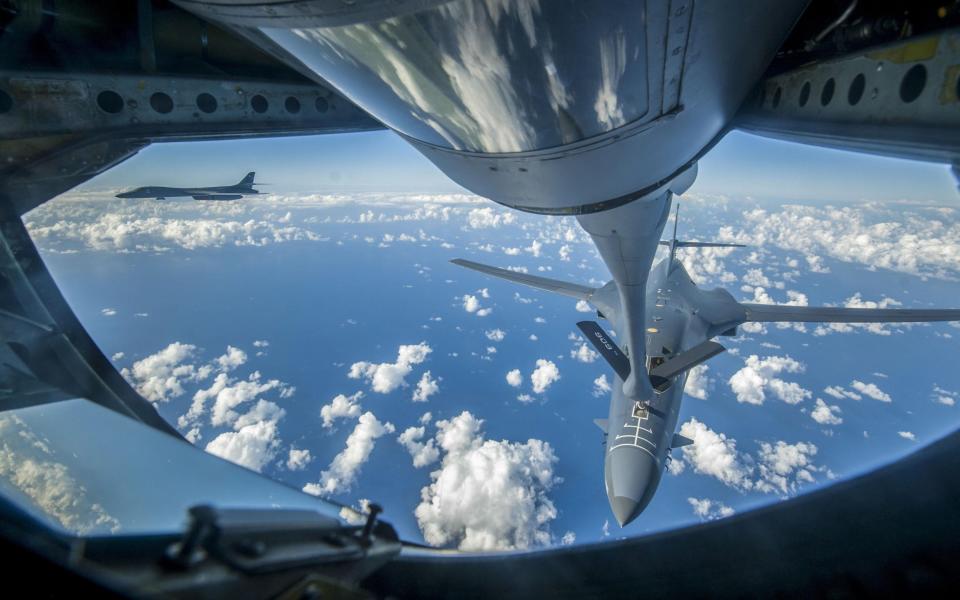The US Air Pressure has 140 of its greatest warplanes – its heavy bombers – in energetic service: 76 Boeing B-52Hs, 44 Boeing B-1Bs and 20 B-2 stealth bombers constructed by Northrop Grumman.
However the Air Pressure has funding for 141 bombers. Its stock dropped to 140 in 2022, when a B-1 suffered an engine fireplace at Dyess Air Pressure Base in Texas – and burned to the bottom. The B-1 is typically often known as “Bone” (from B-one).
Every other air pressure would possibly content material itself with 140 bombers and redistribute the misplaced bomber’s working funds. However the US Air Pressure is relying on the B-1 to play a lead function in a potential air battle over the Taiwan Strait. It’s such a excessive precedence that the service is spending hundreds of thousands of {dollars} recovering, from long-term storage, a surplus B-1 nicknamed “Lancelot” that’s been sitting in desert storage, aka “the Boneyard”, for 3 years.
That is an operation the Air Pressure has completed simply thrice in current a long time. Apart from the B-1, the service returned to flying standing two saved B-52s – one in 2020 and one other in 2015 – to be able to substitute bombers that it misplaced to accidents.
Recovering from storage a machine as complicated as a bomber is difficult, costly and time-consuming work. It could actually take lots of of individuals working 1000’s of hours over a span of years and at a price of hundreds of thousands of {dollars}.
That the Air Pressure is keen to make the funding speaks to the significance of the massive, lumbering warplanes because the service positions itself to, amongst different contingencies, defend Taiwan from a Chinese language invasion fleet.
The four-engine, supersonic, swing-wing B-1 – crewed by 4 individuals and able to carrying 37 tons of bombs and missiles over intercontinental distances – is the Air Pressure’s predominant anti-ship platform. It could actually carry 24 of the service’s greatest cruise missiles, together with its Lengthy-Vary Anti-Ship Missiles, or LRASMs.
A B-1 “can quickly ship huge portions of precision in addition to unguided munitions towards any adversary, wherever on the planet, at any time,” the Air Pressure states. The bomber’s LRASM and its comparable Joint Air-to-Floor Strike Missile, or JASSM, are the important thing weapons for an air and naval battle over Taiwan.
A 1.3-ton LRASM ranges lots of of miles with GPS and inertial steering, an infrared seeker that may acknowledge ships and a 1,000-pound warhead that, with luck, can break an enemy ship’s keel.
To maximise the missile’s lethality, producer Lockheed Martin lately configured it to fly in formations of 4 missiles. The current first take a look at of the four-missile formation “was the following huge step in LRASM’s evolution,” Lockheed boasted. Whereas one LRASM ought to be capable of sink, say, a Chinese language frigate, it would take 4 missiles placing concurrently to place out of motion a Chinese language plane provider.
B-1s firing salvoes of LRASMs and anti-ship-capable JASSMs might devastate a Chinese language fleet crusing throughout the 100-mile-wide Taiwan Strait to land troops on Taiwanese seashores. That was one of many predominant conclusions when the Heart for Strategic and Worldwide Research in Washington, DC gamed out a battle over Taiwan final yr.
“The stock of a number of hundred LRASMs, with a spread of [370 miles], mixed with 1000’s of JASSM-ERs, with even better vary and modest anti-ship functionality, permitting US bombers and tactical plane to quickly attrit the Chinese language fleet from past the vary of its anti-aircraft defenses,” CSIS discovered.
Conversely, to be able to win a battle over Taiwan, China should shoot down – or destroy on the bottom – a good portion of America’s bombers. However “that is onerous to do as a result of bombers will be primarily based past the vary of most Chinese language ground-attack missiles, method the theater from a number of angles and launch standoff missiles past the vary of defending [surface-to-air missiles],” CSIS reported.

It’s no surprise, then, that the US Air Pressure fastidiously maintains the utmost variety of bombers it has funding for. Each single energetic bomber is a versatile and survivable flying missile arsenal able to damaging or sinking dozens of enemy – that’s, Chinese language – warships in a single sortie.
The Nineteen Eighties-vintage B-1s together with the newer B-2s ought to retire in round a decade as new Northrop Grumman B-21 stealth bombers substitute them and, alongside super-upgraded B-52s, take over their roles – presumably together with the B-1’s anti-ship function. Within the meantime, the Air Pressure has loads of inactive B-1s in storage to exchange any extra energetic B-1s that crash or put on out.
That’s as a result of Rockwell, later a part of Boeing, constructed 100 B-1s – dozens greater than the Air Pressure now wants. A couple of have been destroyed in crashes, however the remainder – greater than 40 – are lined up in neat rows on the Pentagon’s “boneyard” for previous airplanes within the Arizona desert.
The dry local weather, plus layers of plastic, assist to protect these beneficial airframes. Every is an insurance coverage coverage towards the accidents or incidents depleting the US Air Pressure’s predominant technique of sinking Chinese language ships.
Broaden your horizons with award-winning British journalism. Attempt The Telegraph free for 3 months with limitless entry to our award-winning web site, unique app, money-saving presents and extra.











